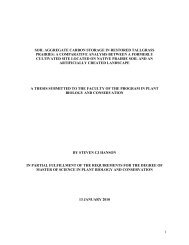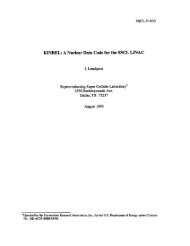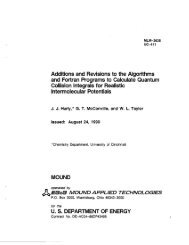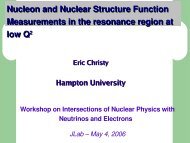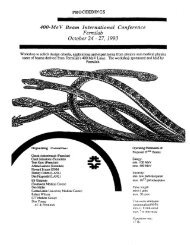Workbook
Workbook
Workbook
You also want an ePaper? Increase the reach of your titles
YUMPU automatically turns print PDFs into web optimized ePapers that Google loves.
43<br />
E-665 (Schellman) Muon Scatteringwith Hadron Detection<br />
ANL, UC / San Diego, Fermilab, Freiburg (Germany), Harvard,<br />
Illinois / Chicago, INP/ Krakow (Poland), LLNL, Maryland, MIT,<br />
Max-Planck (Germany), Northwestern, Ohio, Pennsylvania,<br />
Washington, Wuppertal (Germany), Yale<br />
IStatus: Data AnalysisI<br />
The experiment studies the interactions of muons with average beam<br />
energies up to 500 GeV in various targets and with the capability of making<br />
detailed measurements of the hadrons that emerge from the collision vertex.<br />
To this end, the collaboration has combined two large magnets, the CERN<br />
Vertex Magnet (CVM) and the Chicago Cyclotron Magnet in a spectrometer<br />
that is as powerful as any known. We use this spectrometer in two basic, and<br />
for the most part complementary, ways to explore:<br />
1) The properties of hadrons emerging from deep inelastic muon collisions<br />
in hydrogen and heavy nuclei. It is possible to study single quark<br />
fragmentation and jet physics in the same CM energy range as e+eannihilation<br />
experiments which directly observe gluon radiation. In deep<br />
inelastic muon scattering, the fragmentation of the current and diquark jets<br />
(not seen in e+e-) can be measured relative to the precise knowledge of the<br />
exchanged virtual photon direction. By studying the A-dependence of these<br />
phenomena, we expect to learn new things about the propagation of quarks in<br />
nuclear matter and to use the nucleus as a length scale to study nonperturbative<br />
quantum chromodynamics.<br />
2) Complementing the fragmentation studies are studies of the deep<br />
inelastic structure functions on the same nucleon and nuclear targets.<br />
Although the targets are relatively thin, the high incident muon energy makes<br />
this experiment particularly suited to the study of structure functions at small<br />
XBj «0.02). This region is of great interest in the study of nucleon structure.<br />
Here, all experiments are limited by kinematics rather than rates, and the<br />
increased muon energy available at Fermilab automatically increases the<br />
available kinematic range.<br />
The experiment took data for the first time during 1987-88 using<br />
deuterium, hydrogen and xenon targets. In 1990 the apparatus was<br />
supplemented with a tracking system of drift chambers inside the CVM to<br />
improve the pattern recognition capabilities and resolution of the<br />
spectrometer. With a new target system, allowing targets to be changed every<br />
60 seconds, muon interactions in hydrogen, deuterium, carbon, calcium and<br />
lead were studied. During the 1991 fixed-target run, higher luminosity studies<br />
of hydrogen and deuterium focussed on the difference between the quark<br />
content of neutrons and protons and on the structure of events at the highest<br />
center of mass energies yet available in muon-nucleon scattering experiments.



